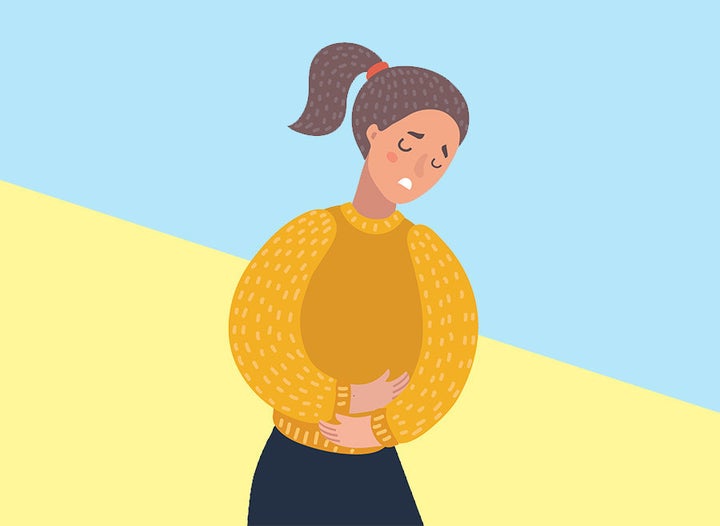A common misconception surrounding Crohn’s disease is that it’s much the same as irritable bowel syndrome (IBS). But while symptoms are similar, the conditions are very different.
Crohn’s is one of two main forms of inflammatory bowel disease (IBD) – which is possibly where some of the confusion lies. “IBD is a structural disease,” Jaina Shah, information manager at charity Crohn’s & Colitis UK, tells HuffPost UK. “The disease causes inflammation and physical damage to the gut.”
In contrast, IBS is a functional syndrome. “Although you get some similar symptoms, such as stomach pain, bloating and diarrhoea or constipation, there is no inflammation or blood loss],” says Shah. “And, if you actually look at the gut, there is no physical damage to the gut tissue.”
[Read more: People with Crohn’s and colitis face abuse for using accessible toilets, survey reveals]

What Is Crohn’s Disease?
Crohn’s disease is thought to affect at least 115,000 people in the UK. The chronic condition causes inflammation of the digestive system – that’s anywhere between the oesophagus and anus.
Shah says the illness can be painful, debilitating and is widely misunderstood. She wants people to know it doesn’t just affect the gut and “isn’t just about poo”. It\s a serious condition that can affect many parts of the body, she says, from the eyes and joints to mental health. “And it can affect many parts of life, from work and education to relationships.”
The disease most commonly impacts the end of the ileum (the last part of the small intestine) or the colon, and areas of inflammation can range in size from a few centimetres to large sections.
It can also fluctuate in severity. Shah explains: “People can experience periods of ‘remission’, when their symptoms are largely under control and periods of ‘flare’ or relapse where they have active and often debilitating symptoms.”
Symptoms
Common symptoms of Crohn’s include:
:: Urgent and frequent diarrhoea (or bloody diarrhoea)
:: Severe stomach pain
:: Extreme fatigue
:: Dramatic weight loss
:: Feeling generally unwell or feverish
:: Mouth ulcers
:: Anaemia
These can vary from person to person and an individual might find their symptoms change over time. Other symptoms include: joint pain, sore eyes and patches of painful, red and swollen skin often found on the legs.
Diagnosis
As Crohn’s shares common symptoms with other conditions like IBS, colitis and coeliac disease, the diagnosis process can often be drawn out. According to Shah, almost half of people wait over a year for their diagnosis and 18% aren’t diagnosed for over five years.
If you have any of the symptoms listed above, you should visit your GP who will ask questions about: how long you’ve been experiencing them for, what your diet is like and family history. The doctor might also examine your stomach, do a blood test and ask you to provide a stool sample, which can be tested for inflammation.
If Crohn’s disease is suspected, you should then be referred to a gastroenterologist for tests to confirm the diagnosis. Here, you might have a colonoscopy (a camera which looks for inflammation in the bowel), a biopsy (which involves small pieces of the bowel being removed to analyse it) and possibly an MRI or CT scan.
You can be diagnosed with Crohn’s at any age, says Shah, but it’s more commonly found between the ages of 10 and 39-years-old. “This means that growth, education and work prospects are often negatively impacted,” she adds.
Treatment
Unfortunately there isn’t a cure for Crohn’s disease. However it can, in some ways, be managed.
“Drugs can be effective in treating symptoms and preventing the disease from progressing and causing serious complications,” says Shah. “These drugs are often anti-inflammatory, and include steroids, immunosuppressants and biological drugs, taken in injection or intravenous/IV infusion form.
“Different medications work for different people. These medications can have side-effects and even people on medication can still suffer from ‘flare-ups’.”
If medication doesn’t work and ‘flare-ups’ keep happening, surgery might be needed to remove the affected section of the gut. Around one in five people with Crohn’s end up needing surgery, according to Shah.
She adds: “If a significant part of the gut is removed, a stoma [or ileostomy] is often needed.” This is where the healthy part of the gut is brought to your stomach wall and your poo is collected in a bag outside of the body.
For more information on living with Crohn’s, check out the NHS website.